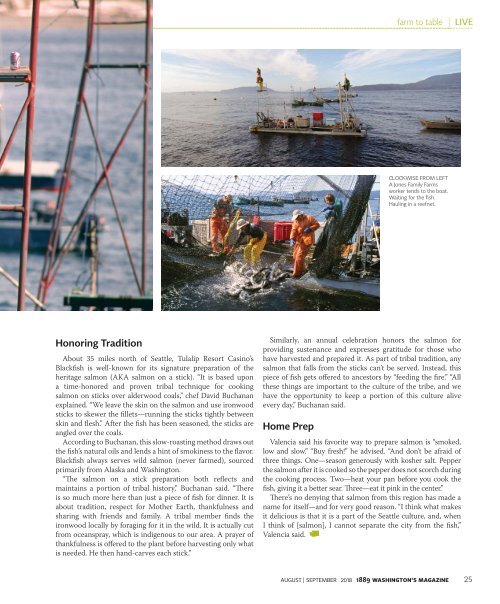1889 August | September 2018
Create successful ePaper yourself
Turn your PDF publications into a flip-book with our unique Google optimized e-Paper software.
farm to table<br />
CLOCKWISE FROM LEFT<br />
A Jones Family Farms<br />
worker tends to the boat.<br />
Waiting for the fish.<br />
Hauling in a reefnet.<br />
Honoring Tradition<br />
About 35 miles north of Seattle, Tulalip Resort Casino’s<br />
Blackfish is well-known for its signature preparation of the<br />
heritage salmon (AKA salmon on a stick). “It is based upon<br />
a time-honored and proven tribal technique for cooking<br />
salmon on sticks over alderwood coals,” chef David Buchanan<br />
explained. “We leave the skin on the salmon and use ironwood<br />
sticks to skewer the fillets—running the sticks tightly between<br />
skin and flesh.” After the fish has been seasoned, the sticks are<br />
angled over the coals.<br />
According to Buchanan, this slow-roasting method draws out<br />
the fish’s natural oils and lends a hint of smokiness to the flavor.<br />
Blackfish always serves wild salmon (never farmed), sourced<br />
primarily from Alaska and Washington.<br />
“The salmon on a stick preparation both reflects and<br />
maintains a portion of tribal history,” Buchanan said. “There<br />
is so much more here than just a piece of fish for dinner. It is<br />
about tradition, respect for Mother Earth, thankfulness and<br />
sharing with friends and family. A tribal member finds the<br />
ironwood locally by foraging for it in the wild. It is actually cut<br />
from oceanspray, which is indigenous to our area. A prayer of<br />
thankfulness is offered to the plant before harvesting only what<br />
is needed. He then hand-carves each stick.”<br />
Similarly, an annual celebration honors the salmon for<br />
providing sustenance and expresses gratitude for those who<br />
have harvested and prepared it. As part of tribal tradition, any<br />
salmon that falls from the sticks can’t be served. Instead, this<br />
piece of fish gets offered to ancestors by “feeding the fire.” “All<br />
these things are important to the culture of the tribe, and we<br />
have the opportunity to keep a portion of this culture alive<br />
every day,” Buchanan said.<br />
Home Prep<br />
Valencia said his favorite way to prepare salmon is “smoked,<br />
low and slow.” “Buy fresh!” he advised. “And don’t be afraid of<br />
three things. One—season generously with kosher salt. Pepper<br />
the salmon after it is cooked so the pepper does not scorch during<br />
the cooking process. Two—heat your pan before you cook the<br />
fish, giving it a better sear. Three—eat it pink in the center.”<br />
There’s no denying that salmon from this region has made a<br />
name for itself—and for very good reason. “I think what makes<br />
it delicious is that it is a part of the Seattle culture, and, when<br />
I think of [salmon], I cannot separate the city from the fish,”<br />
Valencia said.<br />
AUGUST | SEPTEMBER <strong>2018</strong> <strong>1889</strong> WASHINGTON’S MAGAZINE 25
















